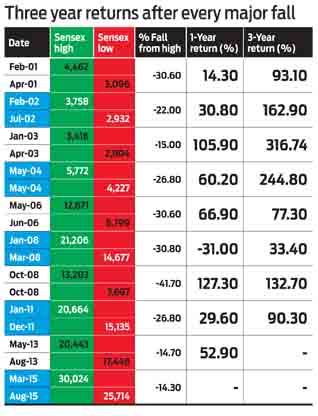The dragon retracts
The impact of yuan’s depreciation is expected to stay longer, but Indian markets are less likely to be severely impacted
Needless to say, the week beginning August 24 will get etched in the Indian stock market history as yet another Black Monday. The drama was further enhanced with headlines flashing erosion of Rs. 7 lakh crore from investors’ wealth in a single day when the Sensex tanked about 6 per cent or 1,624.51 points.
The genesis of this market route goes back to China’s move to devalue yuan. Between August 11 and 14, the Chinese central bank devalued yuan against the dollar and pushed down its value to around 6.39 yuan to a dollar. This was the biggest devaluation of yuan against the dollar in nearly two decades.
The trigger was enough for the domino effect—big sell-off in other markets and battering of commodities like metals, fuels and plastics. Add to it, there was turmoil in the forex market with currencies losing badly, with the rupee taking a beating as well in the wake of heavy FII selling. The Indian stock market indices were also badly hit. And though sharp losses and gains in equity markets is a regular phenomenon, what stood out this time was the explosive rise of volatility.
That the Chinese play an important role was well accepted, but its impact was profoundly visible this time around. The impact of this shake-up has only given rise to concerns regarding economies world over. Add to it the fact that most central banks across the world are following divergent monetary policies—most emerging markets, including India, are unable to stabilise their own finances and international trade to limit damage to their economies.

Market realities
Short-term market moves are largely dependent on fund flows. A large number of portfolios are designed to reduce exposure during turmoil and a rise in volatility. This is a short-term glitch and, in the long run, India will remain well-poised to outperform other emerging markets. What favours India is a controlled inflation when you see crude at $40 a barrel and besides, the falling rupee does not look as bad as it did in 2013 when it had touched Rs. 69 against the dollar and the crude was touching $110 a barrel. If indicators are to go by, the India growth story is showing signs of a pick-up with IIP and the capital goods order book looking favourable.
The Indian market will be dictated by foreign fund flows, which means the volatility will continue and create an opportunity for the patient participant looking to benefit from the long-term Indian growth. There is no cause for worry for long-term investors because there are plenty of indications and past data to indicate that this too shall pass and the mature investor would come unscathed. Of course, the short- to medium-term pain will be felt by traders, but they too benefit from volatility. The data in the table should encourage investors. For, every fall has only turned into a rise over time, if not in one year, then surely in three years. It does not mean one goes into a tizzy to start investing now, but what is important is to stay invested and benefit from the full run. Already, as will go to press on August 27, there has been a marginal gain in the market over the previous day. The other silver lining is that the recent fall may push the US Fed on the backfoot and it will not increase rates in a hurry.
For those who have forgotten, the most significant Black Monday occurred on May 17, 2004, when the Sensex recorded its largest-ever intra-day fall, declining 842 points at one stage (over 11 per cent) on the back of prospects of a Left supported UPA-1. The August 24 fall pales in comparison going just by numbers. As the ancient Chinese curse translates, ‘May you live in interesting times’ and we are doing that exactly thanks to a bursting Chinese market.









